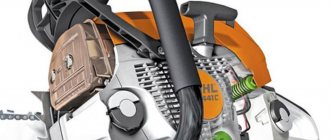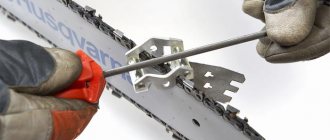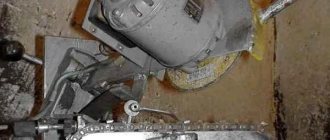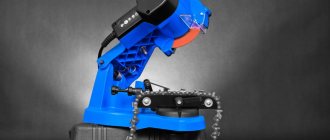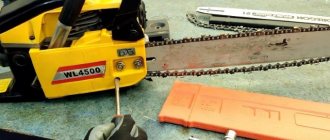Chainsaws are widely used in industry for cutting and processing trees felled during logging, and in private households for gardening, construction, or collecting firewood. In our country, the most common professional saws are those produced by Husqvarna, Oregon, Stihl, and Partner. The chain is an important working part of a chainsaw, the quality of which determines the performance of the saw. This article will tell you about the main characteristics of this saw set. From it, readers will also learn how to determine the right chainsaw chain size.
What elements do chainsaw chains consist of?
Saws with a gasoline engine are used for longitudinal and transverse sawing of tree trunks, as well as finished lumber. However, in order to correctly install a chain of the required size on a chainsaw, you need to know its design, which was invented in 1947 by Joseph Cox and has not changed significantly since then. At enterprises, workers must learn the safety rules when sawing lumber with professional tools. After completing the introductory briefing, you are given permission to work. Choosing the right chain increases the performance of the chainsaw. The saw chain consists of three types of links:
- cutting;
- shanks (leading);
- connecting.
All links are made of high-alloy steel and are connected with rivets. In good quality chains, the cutting elements are made of pobedite or other alloys of increased hardness. They can cut different types of wood, concrete, thin metal and other materials. The incisors can be right-handed or left-handed, and are arranged and stand on a chain in turn. They have a cutting edge and a stop that regulates the depth of cut.
The purpose of the driving links, which are called shanks, is to transmit rotational motion from the saw motor to the chain via a drive sprocket. This ensures its stable position on the removable tire. For reliable fastening of cutters and shanks, the design provides connecting links.
How to find out what type of headset is on a chainsaw
There are several ways to determine the type of chain that is installed on a chainsaw. If the saw is new, just purchased, then the type and size of the chain are indicated in the documents (user manual, in the characteristics section). If the saw has already had time to work and it is not known whether the headset has changed during operation, then you can determine the type of chain by performing the following steps:
- Remove the headset and count the number of links.
- Using a caliper, measure the width of the shank.
- Visually determine the type of cutting tooth. Sharp side edges are chisel, smooth edges are chipper.
- Use a ruler or caliper to measure the chain pitch.
How are saw chains classified?
The quality and speed of cutting depends on the type of saw chain, location and total number of its constituent links. Manufacturers produce chipper and chisel products, differing in the shape of the cutting tooth.
Chains of the first type are installed on professional and household chainsaws. It got its name from the shape of the cutting element. The word chipper translated from English means “chopping into chips.” Indeed, sickle-shaped cutters, rounded at the top, allow you to cut at high speed. However, such chains are less efficient in operation, since they have an increased contact area between the cutting edge and the wood. They are convenient to sharpen, since a precise angle is not required.
Chisel products (chisel in translation means “chisel”) are more often installed on professional equipment. A sharper angle of attack of the working tooth allows you to cut more aggressively into the wood, which increases the productivity of the saw, but reduces the cutting speed. When sharpening them, it is necessary to clearly indicate the correct angle.
Saw parts for chainsaws are also classified by purpose. For cutting down trees and bucking trunks, a transverse chain is used, the sharpening angle of the cutting edge of which ranges from 5 to 15 ̊. To cut along the fibers, you need longitudinal chains, which must be sharpened at an angle of 25 to 30 ̊. The harder the wood, the sharper it is sharpened with a file or machine.
Purpose of the circuit
Many chainsaw users are unaware that the equipment on their tool can vary in the direction of the cuts. In other words, to cut wood across the grain, you need one chain, and for longitudinal cuts, another. The difference between them lies in a number of design nuances, among which the most pronounced are the different angles of attack of the cutters:
- to cut wood across the grain, the angle should be 25–35 degrees;
- For longitudinal sawing you need a chain with teeth with an angle of attack of 5–10 degrees.
This difference is due to the different density and resistance of wood when cutting in one direction or another. Moving along the fibers, the teeth encounter a softer and more viscous medium. To overcome this resistance and prevent bevels and splitting of the wood, they must be sharper. When cutting across the grain, when the risk of longitudinal cracking of the workpiece is minimal, a large angle of attack provides higher productivity.
Thus, when choosing a saw set, you need to decide for what work it will be primarily used. If you have to cut timber for a log house, it is better to choose a chain for cross cutting. But if you plan to saw long boards in the direction of the grain, for example, for cladding facades or laying floors, then you should take a closer look at models for longitudinal sawing.
But the choice of chains of the latter type is rather scarce. In most cases, cutting lumber lengthwise is much more convenient, faster and more efficient on a circular or band saw. But such a tool can hardly be called a panacea - not everyone has it, and buying it for one-time use is very expensive. Therefore, quite often the same chain is used for longitudinal cuts as for cross-cutting. With sufficient skills in working with the tool and the absence of particularly high requirements for the quality of sawing, such equipment can become universal.
At the same time, there is still a demand for rip sawing chains. In particular, they are practically indispensable for mini sawmills and a number of other devices. Therefore, a small number of offers here does not mean their complete absence.
What circuit parameters affect the operation of a chainsaw?
The main performance characteristic of chain saws is performance, which is mainly influenced by engine power and the quality of the saw chain. When preparing the saw for work, it is also important to properly thread it. To do this, first fill the tank with any oil with TC or JASO approval, and then add gasoline. The resulting mixture is thoroughly mixed. The choice of chain is greatly influenced by the capabilities of the tool. When purchasing it, you need to pay attention to the markings, the correct decoding of which will help you select a chain. The following parameters are displayed on the leading links and in the technical data sheet of the chainsaw:
- Chain pitch and size.
- Thickness of leading (shanks) and connecting links.
- Depth and length of cut.
- Number of incisors.
- Sequence of links. To install the required chain on a chainsaw, let’s take a closer look at these parameters.
Calculation of pitch and thickness of shanks
The pitch is the distance from one top of the leading link to the other. To determine this parameter, you need to measure the length between the axes of two nearby rivets, and convert the figure obtained in centimeters into inches, dividing it by 2.54. The larger the pitch, the more productive the saw. However, in order to pull chains with a small pitch, a more powerful motor is needed to rotate the drive sprocket. Manufacturers produce chain products with the most common pitch sizes of 1/4; 0.325; 3/8 (0.375); 0.404; 3/4. In this case, it is necessary that this parameter coincides with the pitch of the driving and driven sprocket. However, there are non-standard saws, for example, Caliber BP 220-18U, the pitch of which is 0.366. When operating a chain saw, the main load is borne by the chain, the strength of which depends on the thickness of the shanks and connecting links. You can measure it with a caliper. For example, the Chain Saw Caliber BP-1800 has a chain thickness of 1.3 mm. The thicker the links and the wider the guide groove of the tire, the stronger the grip. To operate such a chain, a powerful chainsaw is required. The impact during operation and the cutting speed depend on the cutting depth. It is directly proportional to the cut.
How to find out the profile size and height
The cutting depth is affected by the profile height and the number of cutting elements. The higher it is, the deeper the tooth goes into the wood being cut, causing vibrations that wear out the chainsaw drive faster. You can now buy low-profile and high-profile chain products. Typically, low profile chains have a longer pitch and are more often installed on household tools. The length of the cut is comparable to the distance between the stop and the tip of the bar. It indicates how thick a trunk or workpiece can be cut with a chain saw.
The size of the chain depends on the number of driving links. Its size depends on the performance characteristics of the saw with an internal combustion engine and corresponds to the length of the bar. The technical data sheet indicates the bar length suitable for certain models of chain tools. To avoid damage, it is advisable to follow these recommendations. Sometimes, in order for a longer chain to fit the bar, it is shortened by removing several links. This is prohibited, since it is impossible to rivet it reliably using a homemade method, and it can tear during operation, injuring others. However, the length of the bar does not determine the exact size of the chain product. Before purchasing, its total length can be calculated by removing it from the package by the number of shanks or connecting links. It is not critical if there are a couple more links in the roll. The chain can be tightened using a tensioning mechanism.
Sequence of links
Companies that produce such equipment and spare parts for it produce chains in which the links are arranged in different sequences, which determines the efficiency of operation. Depending on the location, there are the following types of circuits:
- standard location;
- with semi-pass;
- with a pass.
In the first type of chains, there are two shanks for each cutting element. In products with a semi-pass, the links after two are replaced with connecting links, and with a skip, instead of every second cutter there is a connecting link. Skip chains have lower performance and wear out faster.
How much does a mountain bike chain cost?
Let's say you have a semi-professional off-road bike with 27 speeds. A 9 Speed chain will suit him. Focusing on average and high quality, we will select 2 models from each company and compare prices.
| Manufacturer | Model | Price, rubles |
| Shimano | CN-HG53 | 1 500 |
| CN-HG93 | 1 700 | |
| SRAM | PC-951 | 1 300 |
| PC-991 | 2 300 | |
| Campagnolo | Record | 3 000 |
| KMC | X9 | 3 200 |
| X9SL | 3 800 |
Why do you need a table that determines the sizes of chains?
The reasons that reduce the productivity of saws with an internal combustion engine are incorrect selection of size, profile height and chain pitch. When purchasing it, you need to carefully study the markings on the closing links, as well as the performance characteristics indicated on the packaging. If it is impossible to decipher the marking and there is no packaging for the product, the best way is to select the product according to the size table. They can be found on the official websites of well-known manufacturers, such as Uskvarna, Shtil, Oregon. Let's look at these tables that will help you choose the right size chain for your chainsaw. The left column contains the most common models of chain saws in our country. The following columns contain the main parameters of saw units. Once you find the right model, you will quickly find out which chain will fit your tool. For chainsaws produced by one company, chains produced by other companies may be suitable.
Size chart for Stihl chainsaws
| Model | Step | Cutting depth | Tire length | Number of links | Product from Stihl | Husqvarna chain |
| MS 180, 230, 250 | 3/8 | 0.013 cm | 0.3 meters | 55 | 63 PM 50 /55 | H 3550 /55 |
| MS 260, 280 | 0,325 | 0.016 cm | 0.38 / 0.4 meters | 62 | 26 RMC 62 /67 | H 2562 / 67 |
| MS 650, 880 | 0,404 | 0.016 cm | 0.4 / 1.5 meters | 60 / 173 |
Size chart for Husqvarna saws
| Model | Step | Cutting depth | Tire length | Product from Stihl | Chain made by Husqvarna | Oregon product |
| 236 | 3/8 | 0.013 cm | 0.35 meters | 63 PM 52 | H 3552 | 91P52 |
| 137, 235, 345, 353, 440, 450 | 0,325 | 0.013 cm | 0.38 meters | 23 RMC 64 | H 3064 | 95VPX 64 |
| 262, 272, 365, 395, 570, 576 | 3/8 | 0.013 cm | 0.45 / 0.5 meters | RM35 68 / 72 | H 42 68 / 72 | 73LPX68/72 |
| 55, 257, 359, 460, 555 | 0,325 | 0.015 cm | 0.38 meters | 25 RMC 64 | H 25 64 | 21 LPX 64 |
| 3120 | 0,404 | 0.016 cm | 0.61 meters | RM46 76 | H 6476 | 59 L 76 |
Chain Definition Chart for Champion Tools
| Model | Step | Cutting depth | Tire length | Chain made by Stihl | Husqvarna product | Oregon chain |
| 137, 240 | 3/8 | 0.013 cm | 0.4 meters | 63 PM 56 | H 3556 | 91 VXL 52 |
| 55, 250 | 0,325 | 0.013 cm | 0.45 meters | 25 RMC 72 | H 2372 | 20 LPX 72 |
| 254 | 0,325 | 0.015 cm | 0.45 meters | 26 RMC 72 | H 25 72 | 21 LPX 72 |
In conclusion of the article, it must be said that the correct selection of chain products is an important task that increases the performance of a chainsaw and increases its service life. Using the size chart, you will buy the right chain of good quality.
When and how to change a bicycle chain
The problem with the chain and, in fact, the reason why you have to choose a new chain for a multi-speed bicycle is one - stretching. Each pin (axis) bores the seat and the chain lengthens, causing damage to the system sprockets and cassette.
It is not economically profitable to ride on one chainstay (unless we are talking about Campagnolo). Over 1,000-1,500 km it will stretch out and start slipping on the stars and eventually you will have to change the chain + cassette. And this is another +3,000 rubles.
There are currently only three working and economically feasible schemes for operating bicycle chains:
- Change the chain in a timely manner. Buy a gauge or caliper and periodically measure the distance between the links. If the internal size of the “bar” is in the range of 120.6-120.9 mm, then the chain is already beginning to actively grind out the cassette teeth and must be replaced. The caliber replacement zone occurs when the 0.75% foot begins to fail. The rear sprockets can withstand no more than 3 chain changes.
- Immediately buy three average chains and use them in a circle. Each bicycle chain is used until noticeable wear (0.75%), then the first one is installed and used until it stretches 1% in caliber. Do the same with the other two chains. Next, product No. 1 is placed again and used until the slippage effect appears and is thrown away. The rest of the pair rolls out in the same way. After all chains have exhausted their service life, the cassette and system stars are replaced.
- Take a Campagnolo and a cheap Shimano cassette and don't bother with all-round changes and calibers. When it starts to slip, replace the chain and cassette. The next installation of new rear sprockets should be combined with the replacement of the system.
Don't forget to handle the chains. The lubricant should not cling to sand and dust, so before processing, read up on how to lubricate a mountain bike chain and how to do it so that the process is truly beneficial.
How to choose
The selection issue is relevant for inexperienced users. Professionals know almost everything about the headset and know how to choose what they need. For this reason, our advice will be aimed specifically at amateurs, and not at pros. So let's get started.
In order to choose correctly you need:
- Know the characteristics of the chainsaw, namely the pitch and length of the bar. When choosing, you should not rely on the name and model of the chainsaw, because... One chainsaw can be equipped with tires of different lengths and seat widths.
- Decide in advance on the volume and type of work for which you plan to use it. If you cut across, we choose chisel ones; if we cut along, we choose chipper ones.
Important! You will have to sharpen it for a longitudinal cut (10 0) yourself or at a service center. A headset sharpened for longitudinal cuts is rarely found on sale
Separately, it is necessary to mention the choice of the Shtil headset. If you are planning to buy a chain from this manufacturer (they are considered the highest quality today), then to make your choice it is better to use a special search form, which can be found on the company’s website.
By entering the chainsaw data into the search form, the program will automatically select and offer you suitable options. The service is convenient, but has one big drawback: selection is carried out only according to Shtil chainsaw models. In order to select a chain for saws of other brands, you will have to arm yourself with a catalog.
Saw chain pitch characteristics
To select the right chain, it must match the tire in its length, width and other structural elements.
Household appliances are most often equipped with chains with a pitch of 3/8 “. They are characterized by a smooth ride and a sufficient degree of reliability and safety.
Professional class models with high cutting speed and increased power use a larger pitch link - 0.404“.
Trying to match such a tire to a household chainsaw will most likely lead to its overload, increased wear and rapid failure of engine and transmission parts.
How to find out
To determine the pitch of the chain used on your chainsaw, you usually use one of the following methods:
- Remove the tire and read the markings on the shank. In addition to the required parameter, the length of the headset, the width of the groove between the cheeks, and the sprocket module must be indicated there.
- If there is any packaging left, you can look at it. Leading manufacturers print on it not only the pitch, but also the type of tooth, width, and file number for sharpening.
- Using a caliper, measure the distance between two adjacent link parts. These can be the bases of the teeth, their tail parts, or the centers of the rollers. For the videos you need to take THREE adjacent ones.
The performance of the tool directly depends on the pitch, which is why it is larger in professional models. It is strictly not recommended to fit tires with a small pitch to powerful chainsaws. Underloading the engine will also lead to accelerated wear of its parts and reduce the service life of a high-quality, productive chainsaw.
If you plan to use a tool for figured wood or ice carving, then, on the contrary, you need to select a chain with a minimum pitch. Teeth located at a small distance from each other provide excellent cutting accuracy and create less vibration.
For each class of operations, it is better to choose a separate chainsaw that best matches its characteristics.
When selecting grooves and cutting out internal cuts, you have to work with the very end of the bar. In this case, there is a high probability of rebound (or rebound) of the saw. This is another reason for purchasing two saws: a powerful, high-performance one for mass operations and cutting thick logs or beams, and a small model with a short headset and a small pitch for finishing figured cuts, grooves and other thin parts.
Cutting depth
Characterized by the height of the cutting teeth.
There are:
- High profile – tooth height 0.762 mm;
- Low profile - tooth height 0.625 mm.
After analyzing what types of chains there are and their characteristics, it is worth understanding for what purpose a chainsaw is needed.
When purchasing a brand, it often decides whether to take the product or not. In the case of chainsaws and chains for them, this is the main factor in quality and price. Sometimes it is better to overpay and be confident in your purchase.
The leading positions among buyers in the market are occupied by:
- OREGON CUTTING SYSTEMS. An American brand whose chains are the quality standard for many manufacturers, as they are durable and place low stress on the chainsaw. But due to the high price of products, residents of the Russian Federation and CIS countries prefer to buy analogues;
- Stihl. The products of this company perfectly fit the slogan “German quality - good price.” The chains are worked to a very good level and are assembled from durable alloys, have low vibration and a competent link lubrication system;
- Bison A domestic brand with a fairly rich assortment. Advantages compared to competitors are the durability of the chains and their low price. However, the teeth quickly become dull and there is vibration;
- Caliber. Also a domestic company that has won its place thanks to relatively low product prices. The chains are strong and sharp, but have strong vibration.





